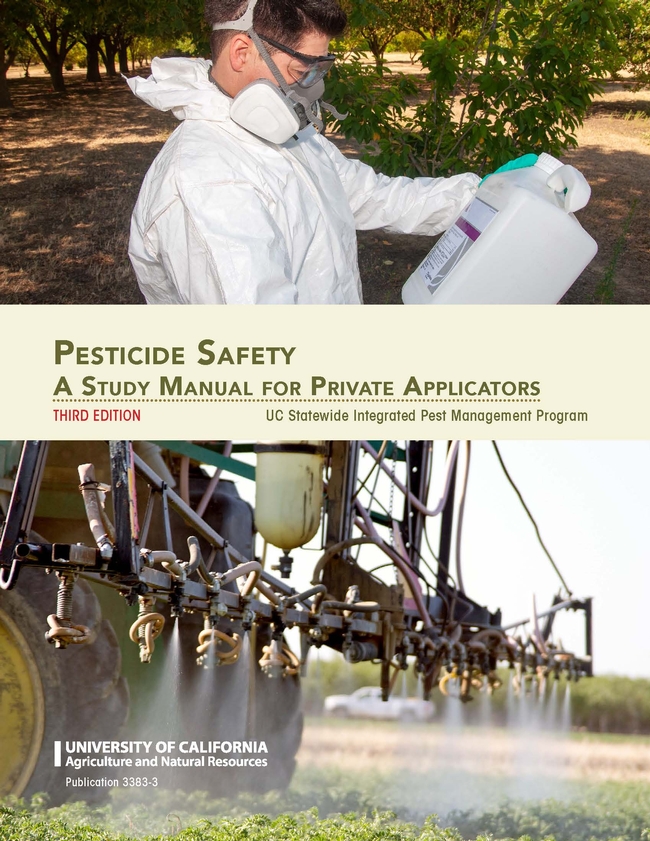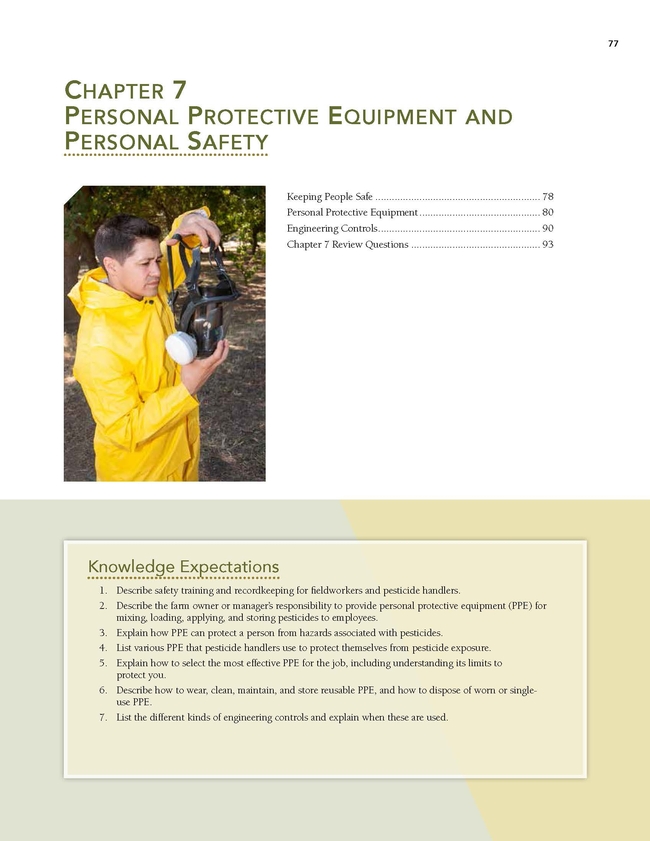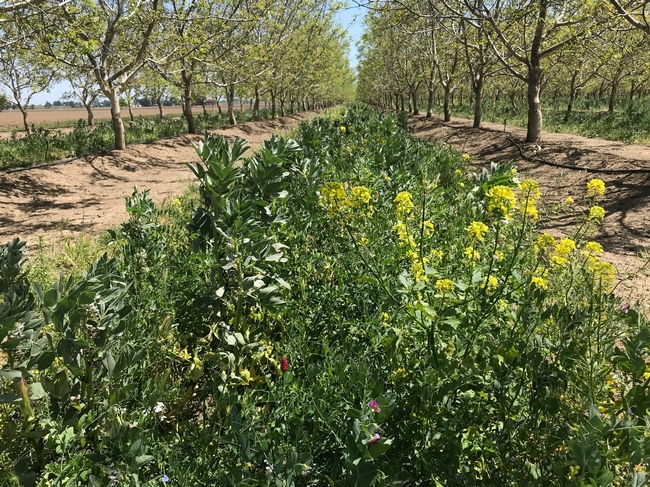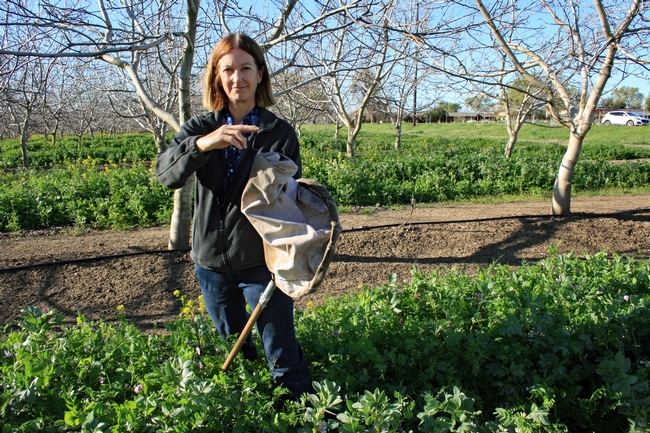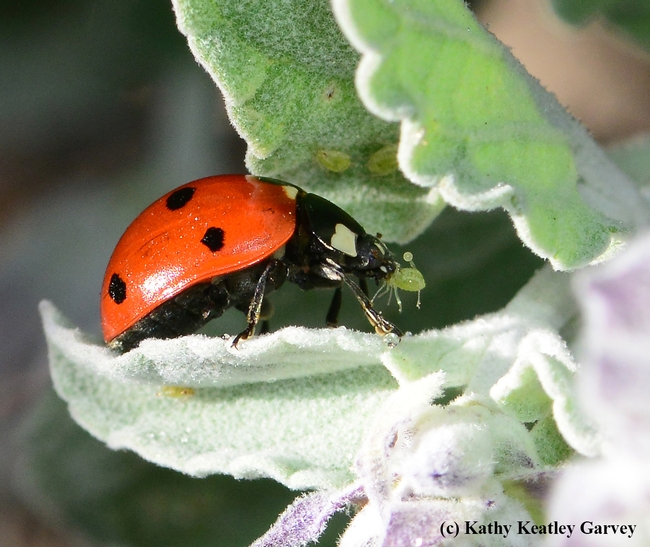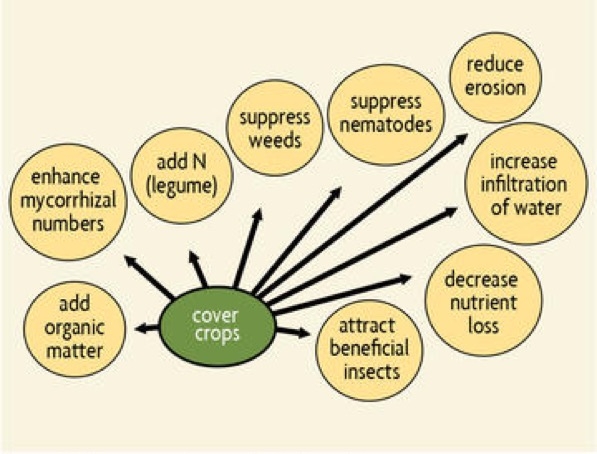Posts Tagged: @ucanr
More detail, key updates in new edition of pesticide safety manual
Publication in English, Spanish prepares private applicators for state exam
Expanded from four chapters in the previous edition to 12, the third edition of Pesticide Safety: A Study Manual for Private Applicators aims to be more than just a study guide.
The manual, available for purchase in English and Spanish, provides much more detail on essential processes and procedures that will help keep applicators safe while using pesticides – as well as reduce environmental impacts from misapplication.
Published by University of California Agriculture and Natural Resources in collaboration with the state's Department of Pesticide Regulation, the manual – intended for members of the agricultural community who own, manage or work on farms that use restricted-use pesticides – also includes substantial updates.
“The information in the book they were using was way out of date,” said writer/editor Shannah Whithaus, senior editor for pesticide safety education with UC ANR's Statewide Integrated Pest Management Program. “Also, the book was much, much shorter than it needed to be, because it wasn't providing enough information for people to safely apply pesticides, given the complexity of the regulatory environment we're in now.”
The new manual reflects important changes to federal and state regulations since the publication of the previous edition in 2006.
“There are significant regulatory updates which help you stay up-to-date with safety rules and standards – and protect your workers from overexposure to pesticides,” said Lisa Blecker, technical editor of the publication, and currently a pesticide safety educator at Colorado State University.
In addition to emphasizing the broader ecological ramifications of improper pesticide use, the manual includes information on subjects that might get short shrift in other manuals, such as the correct calibration of equipment to ensure accuracy of application.
“All of that is now in the book and fully fleshed out,” Whithaus said. “[Applicators] are going to be able to do that much more effectively using the new book, compared to the old one – it was really hard to be thorough in 80-some pages.”
The new edition – totaling more than 200 substantive pages – also features a more streamlined and user-friendly layout modeled after a sister publication, The Safe and Effective Use of Pesticides, written for commercial applicators.
“A significant update is a layout that is not only beautiful, but helps you identify key information you need to know in order to make safe and effective pesticide applications,” Blecker explained.
She highlighted the “knowledge expectations” listed at the beginning of each chapter and in the margins of the book, next to the relevant passages. The statements serve as “visual cues” to help readers learn and retain the material they need to pass California DPR's certification exam for private applicators.
And while the manual functions as an improved study aid for owners, managers and workers who apply pesticides, it doubles as a reference that they can turn to for years to come.
“It's going to be able to serve as a reference manual, as opposed to just a study guide,” Whithaus said. “You really will be able to use this book as a tool to help you do better in managing your land.”
The manual, listed at $29, is available for purchase in English at https://anrcatalog.ucanr.edu/Details.aspx?itemNo=3383 and in Spanish at https://anrcatalog.ucanr.edu/Details.aspx?itemNo=3394.
Grow cover crops to attract beneficial insects, add nutrients, suppress weeds and build soil
George Washington, the father of our country, said it well when he proclaimed he grew “crops to eat and sell” and “crops to replenish the soil.”
Generations of farmers follow his footsteps.
Cover crops (also known as green manures) are plants primarily grown for the benefit of the soil rather than for crop yield. With autumn only a few months away, now's a good time to think about planting cool-season cover crop seed mixes for your farm or garden.
Why grow cover crops?
The benefits of cover cropping include reduced soil erosion, adding organic matter, nutrients, and mycorrhizae to the soil, and weed and nematode suppression. Cover crops also increase nutrient retention and water infiltration. And some, such as radish, break into compacted soil layers, making it easier for the following crop's roots to develop more fully. Flowering cover crops on farms also increase beneficial insects, including bees and natural enemies, that provide pollination and pest control services in crop production.
How do cover crops benefit natural enemies?
Beneficial insects need nectar and pollen to survive and reproduce. For example, adult parasitoid wasps feed on flowers, while the parasitoid larvae prey on pests such as aphids, caterpillars, and stink bugs. Lady beetle, aka ladybugs, feed on flowers, especially during times of prey scarcity. In addition to flowers, cover crops, such as vetch and bell (fava) beans, have extra-floral nectaries or spurs at the base of the leaves. These secrete a sugary syrup that attracts beneficial insects, such as syrphid flies to control aphids.
Insectary cover crop seed mixes.
Winter mixes that attract beneficial insects (aka Insectary Plants) and fix nitrogen include bell beans, clovers, field peas, and vetch. Other insectary plants to add to a cover crop mix include forbs such as baby blue eyes, poppies, phacelia, purple Chinese houses, sweet alyssum, and tidy tips. Small grains (triticale, barley, and rye) are good pollen sources for beneficial insects. It's a good idea to order insectary cover crop mixes from local sources to avoid potential introduction of non-native forb-type plants from other areas.
Cover crops to perhaps avoid in some crop rotations.
Avoid cover crop species that host arthropod pests or plant pathogens that can damage nearby crops. For example, bell beans are a key host for tomato spotted wilt virus vectored by thrips insects, UC IPM. Mustards attract beneficial insects, but are significant hosts for pests such as stink bugs, cucumber beetles, flea beetles, and lygus bugs. Alfalfa has extra-floral nectaries, but is not a recommended insectary plant because it hosts pathogens, including alfalfa mosaic virus that infects a number of crops, including tomatoes (UC IPM).
How important are floral resources for natural enemies?
In a 1998 research article, Beneficial insects move from flowering plants to nearby crops, published in California Agriculture journal, I pointed out that beneficial insects extensively use flowering cover crops. In a mark-and-recapture study in an almond orchard with a cover crop, 80 percent of the syrphid flies and 40 percent of the lacewings (both aphid feeders) trapped in the trees fed on flowers and extra-floral resources that the insectary plants provided, as did 10 percent of the parasitoid wasps, which prey on peach twig borer.
Balancing multiple needs of cover crops.
Note that legumes need to be mowed or disked prior to full bloom for maximum nitrogen fixation, limiting floral resources. To favor beneficial insects, don't mow or disk all of your cover crop at once; instead, leave occasional strips of flowering plants on your farm. Beneficial insects will find the flowers, as they move around (at least 600 feet for many natural enemies and over a mile for bees). If frost is a concern in your orchard, consider planting strips of low-growing insectary plants, such as tidy tips and other forbs listed above. Be sure to select seed mixes that work with surrounding crops.
George Washington used cover crops to replenish the soil; they're also good for the soul when you savor the benefits, especially all the flowers and beneficial insects attracted to them. Why not play a game of “I Spy” in your cover crop and see if you can find a bumble bee or one of the myriad of natural enemies featured in the UC IPM poster, Meet the Beneficials.
Additional reading
Flowering cover crops support wild bees and a regional sustainability agenda, part of the June 2018 research update in California Agriculture journal.
UC ANR publications on cover crops:
Cover crops for California Agriculture
Cover Cropping for Vegetable Production
Cover Cropping and Conservation Tillage in California Processing Tomatoes
Cowpea Production: Sample Costs and Benefits as a Summer Cover Crop
Cover Cropping in Vineyards: A Grower's Handbook
Cover Crops for Walnut Orchards

